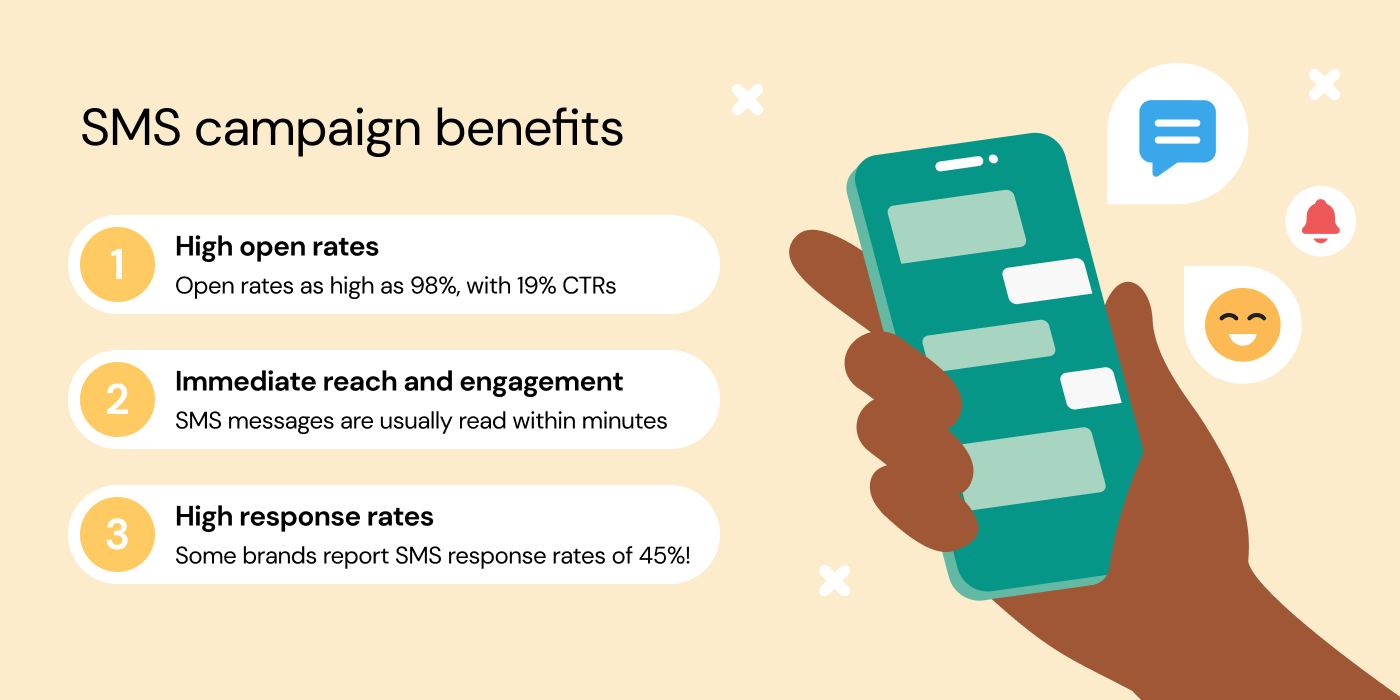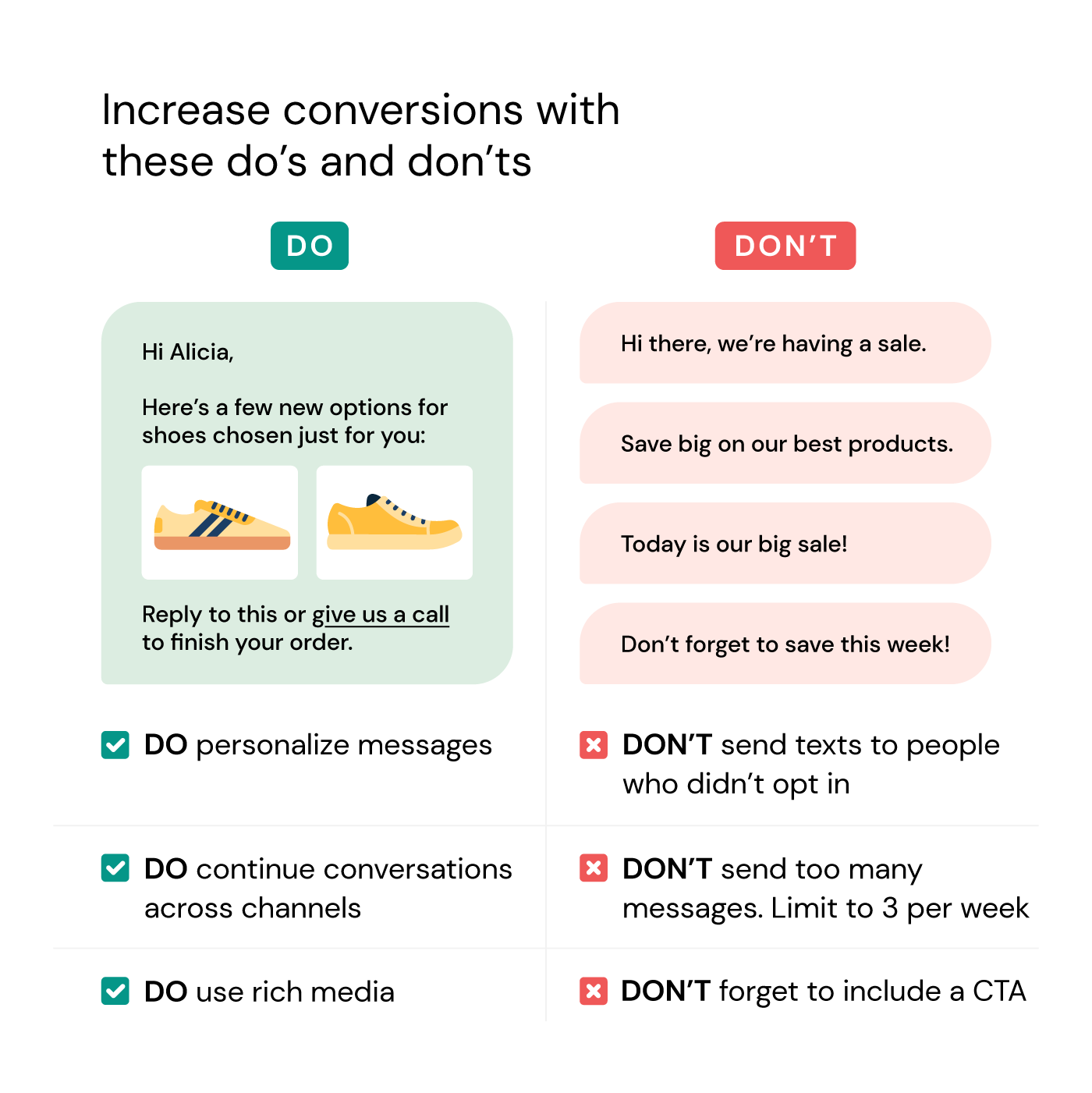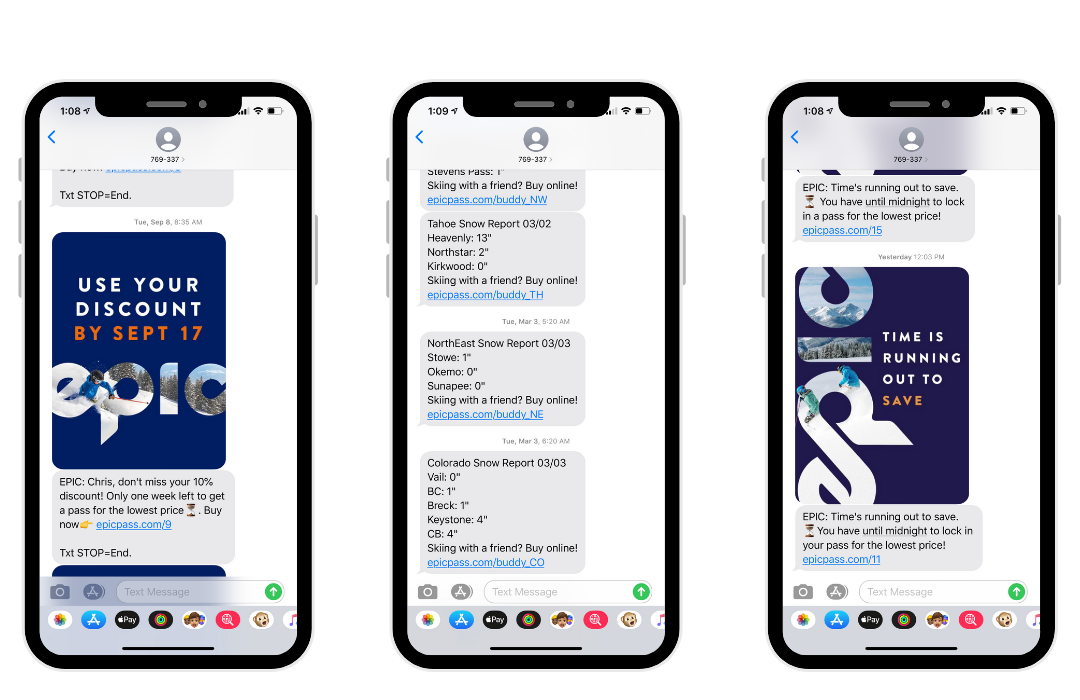Okay – let’s assess where we are with regard to SMS marketing. You probably already know all about the super-high open and click-through rates of SMS compared to other marketing channels. Maybe you’ve seen the data about how many people prefer and desire to interact with companies via SMS rather than through a phone call. Now, you want to create an SMS campaign and start using this highly-engaging channel to reach more of your customers.
So how do you begin?
It’s time to move beyond the idea stage and into implementation.
To do that, you’ll need a clear understanding of the core elements of a winning SMS campaign, and the steps it takes to create and send that campaign to your SMS subscribers. And that’s what you’ll find in this article!
What is an SMS campaign?
An SMS campaign is a targeted marketing strategy that involves sending text messages to a particular audience to promote your products or services.
As you know, SMS marketing campaigns get very high engagement. They have a high open rate – nearly all your subscribers will see your marketing texts. And because text messages are so short, even a quick glance at your message usually means that they’ve read the entire thing. You can get your whole message across nearly every time.
There are a few limitations when it comes to SMS, like its 160-character limit. You can’t use SMS to send expansive messages, share detailed stories, or dive deep into features and benefits. SMS campaigns must be short, to the point, and direct.
You also can’t send visuals like images, videos, or graphics with SMS. So your written text has to deliver the entire message and provide motivation to take action.

SMS campaigns have several important benefits, like high open rates, engagement, and response rates.
How to create an SMS marketing campaign
Let’s take a quick look at the essential components that should be part of every SMS campaign. Build your campaign around these, and you’ll be setting yourself up for success. Sound good?
Get opt-in
To remain compliant with various regulations (more on that in a minute), all of your SMS marketing recipients need to freely consent and subscribe to receiving your marketing texts. That means they need to opt in.
You can incentivize more opt-ins using a variety of strategies. You can pursue new subscribers using single or double opt-in, and also offer SMS to your existing email subscribers who are already familiar with your brand.
For brand new subscribers, double opt-in is better because it confirms that the phone number they used to sign up is real.
Make sure your SMS messages are compliant
SMS communications have far more stringent compliance requirements than email. If you don’t remain compliant with the regulations, you can get fined, or worse.
How do you avoid getting in trouble with your SMS campaigns?
Following a few simple requirements takes care of most potential issues:
- Keep your content free of inappropriate material.
- Make your subscribers understand what they’re agreeing to when they opt in for your SMS marketing messages.
- Don’t send SMS marketing messages outside normal hours – people may resent being contacted in the middle of the night.
- Honor opt-outs and remove people from your subscriber list if they unsubscribe.
Use a template
The idea behind SMS templates is to maximize your efficiency as a marketer, but you should still customize your message to each recipient. Just like you can with email and other forms of direct marketing, you can insert personal information about each recipient using fields for things like names, dates, cities, and business names. You can also include information like coupon codes, your website or landing page, and the specifics of your offer.
To speed this up, you can use SMS templates for text message campaigns such as welcome texts, thank you texts, limited time offers, new product launches, holiday specials, abandoned cart texts, appointment reminders, order confirmations, shipping updates, retention campaigns, and many other common situations.
Don’t forget your call to action!
For transactional texts like notifications and confirmations, you might not need a call to action. But for promotional texts – including welcome messages – this is an essential component of your SMS campaign.
Because text messages are limited to 160 characters, you need to keep your call to action short and clear. Tie it to whatever promotional message you’re sending. Here are a few short and sweet CTAs that work great for SMS marketing campaigns:
-
Claim discount
-
Buy today
-
Use coupon
-
See video
-
Take poll
-
Rate experience
Track and iterate
The final essential component of SMS campaigns is to have a way to track the data. You want to know the click-through rates for your CTA. You want to know how many people used your coupon code, took your abandoned cart offer, or registered for an event or webinar – based on your SMS campaign.
With this data, you’ll understand how well your campaigns are working so you can optimize future campaigns that continue to engage and serve customers and subscribers in ways they appreciate.
If you aren’t tracking and monitoring your data, you won’t know what’s working and you may see your unsubscribe rate rise.

SMS marketing campaign dos and don'ts to drive conversions.
5 SMS campaign strategies to try
Try lots of strategies and ideas. Don’t get boxed in to the same routine. Break out and use a variety of approaches to keep your subscribers engaged and interested in hearing from you. You’ll make a much greater impression! Here are a few ways to raise your SMS marketing game:
1. Research the right time to send
This is about much more than just the time of day and time zones – but those are very important, too. You want to send SMS marketing messages when people are awake.
Even more than that, you want to send marketing texts when the subscriber is most likely to be able to take action.
For example, suppose you want to send out a flash sale to a particular segment of your SMS subscribers. When are these people most likely to respond to this time-sensitive offer?
If you have a store that catches people on their way home from work, you’d want to send this out in the late afternoon so it’s fresh on their mind and they can act on impulse.
If it’s an online-only offer, you might want to catch people at lunch or perhaps on the weekend.
If it’s a B2B message, you might want to hit them with it first thing in the morning, before they get wrapped up in their day.
When looking at times to send your SMS campaign, consider factors like:
-
When your target audience is most likely to be active and available
-
The nature of the offer
-
The deadline, if any
-
Your industry and the habits of its customers
-
Previous data from earlier campaigns
-
Your other marketing efforts and channels and how SMS integrates with them
2. Craft compelling, concise messages
Remember – you’re limited to 160 characters, which includes compliance language, like informing subscribers they can text STOP to opt out. So whatever you say, make it count. Make it irresistible.
You may also consider creating a short series instead of a single text, and sending a sequence of SMS messages over a few days or weeks that all relate to the same campaign.
This approach allows you to touch on different benefits or aspects of the campaign, rather than trying to cram it all into one short message. But take care not to overdo it. Chances are, your subscribers don’t want to hear from you via text messages every day. So if you create a campaign with more than one text, space them out.
3. Use personalization that converts
Using information like names, businesses, cities, and dates that mean something to the recipient makes the message more personal and compelling. It feels more like it was sent just to them, and can result in increased response rates.
When you get a text, most of the time it’s from one person, right? A company can achieve a similar effect fairly easily by personalizing their text campaigns.
Vail Resorts used this simple SMS marketing strategy to increase the number of lift tickets purchased. They sent personalized marketing texts with special offers to subscribers who opted in for current snow reports.

Vail Resorts uses personalized SMS marketing campaigns to grab their customers' attention.
This targeted contact list included people who were most likely to be interested in skiing, so offering deals on lift tickets to this group was a smart strategy that helped the resort operator increase engagement and purchase rates.
4. Try SMS automation
You can achieve great results using SMS automation like welcome messages and abandoned cart texts. These are promotional texts that go out based on actions taken by a subscriber or customer. And they result in new revenue and happy customers.
5. Use SMS with other marketing channels
SMS marketing campaigns can produce great results in terms of engagement and sales. But when you make SMS one part of an omnichannel marketing campaign, your results can exponentially improve.
The reason this is effective has to do with the natural way humans respond to advertising. Repeat ads from the same source tend to get lost in the noise.
But when we hear the same number of ads on a variety of channels that tell different pieces of a brand story, it feels more like just part of the day.
Think about it:
Suppose you see an advertisement on a billboard, then a TV ad later that day, then a display ad on social media, and then an email and later a text – all from the same company.
How would you feel about it? This experience feels like hearing one message at a time, in each case. But if you got five emails, or five texts, or saw five TV commercials all from that company in a single day, you’d feel very differently about it.
Omnichannel marketing gets your message out more effectively because you encounter less resistance while still benefiting from repetition and reinforcement of your message. Make your SMS campaign part of a larger omnichannel approach, and you’ll strengthen your marketing efforts.
The impact of a great SMS campaign
When you produce and send an effective SMS campaign, you can evaluate it using a number of key performance indicators (KPIs). Here’s a quick overview of how to measure your next SMS campaign:
-
Conversion rates. SMS tends to earn click-through and conversion rates that are far higher than email. Measure things like sales, signups, surveys completed, coupons used, or whatever other conversion metric is appropriate for your campaign.
-
Customer engagement. This can also include clicks depending on the campaign, as well as opens and other forms of engagement like replies.
-
Website traffic. Monitor real-time incoming traffic sources on the landing page connected to your SMS campaign. Then you’ll know not just how many SMS subscribers visited the page, but can use your other web analytics tools to measure their behavior after the click.
-
Abandoned cart recovery rates. Track how many shoppers who left items in their cart returned to purchase them after your abandoned cart texts go out.
What is the success rate of an SMS campaign?
Remember – the ultimate goal of your marketing campaign is what drives the KPIs you’ll measure. Are you generating the revenue you hoped for? Are you getting the engagement, signups, reviews, or other results you want? That’s how you’ll measure your success rate.
And whether your campaign is measured by certain types of conversions, engagement, traffic, or other KPI data, that’s why a multichannel marketing approach should be something you strongly consider.
Email marketing can fulfill certain marketing strategies that SMS simply can’t. And SMS marketing can perform certain tasks better than email. When used together, you get the benefits and advantages of both.
The success of your SMS campaign multiplies when you combine it with the advantages offered by other digital marketing channels. You can also look into additional forms of marketing that make use of mobile phones but that leverage increased functionality, such as using conversational marketing through RCS.
Get started with your first SMS campaign
SMS campaigns have the great advantage ofsuper-high engagement. Nearly everyone you send a text to sees the message. And, in many markets, the cost to send texts is low compared to other marketing channels.
Use the SMS campaign strategies and tips from this article, and get started on your first campaign.
Here are some additional resources you may find helpful as you get started:
First, you’ll need an SMS API to integrate your SMS marketing platform with your other marketing tools.
You’ll also need an SMS provider, and there are several things to consider when choosing the one that will be best for your company.
It’s also helpful to study how SMS can be used effectively in particular situations such as Black Friday, and in certain industries, such as ecommerce or retail.
Speak to one of our experts to put your plans into action today.



